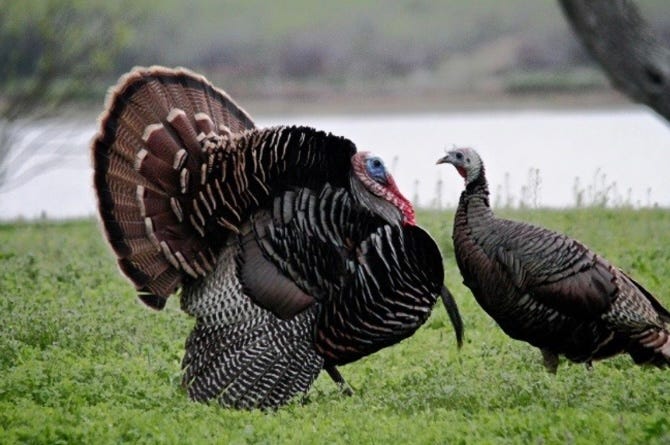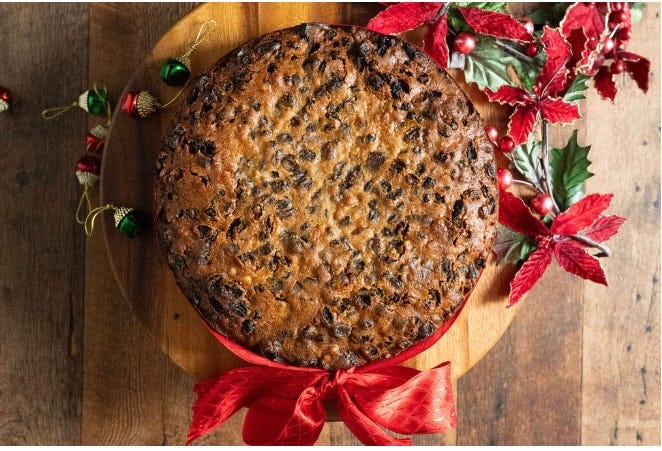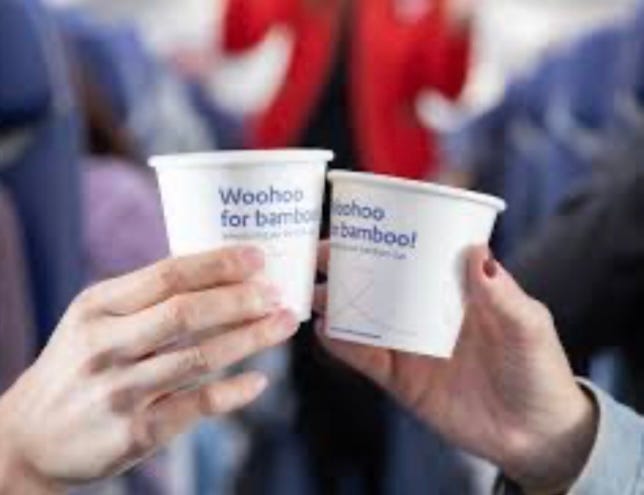Hello, and happy holidays! I hope your Thanksgiving went smoothly, whether you were home or traveling. I spent the holiday in Ann Arbor, where we were unexpectedly treated to snow on Black Friday. It initially was the kind that looks pretty on your lawn but quickly melts on roads and sidewalks. However, we got a second round that snarled traffic this weekend. Be careful out there!
For our new subscribers, CulinaryWoman brings you stories reported by me, plus some shorter pieces that I think might be intriguing. Our paid subscribers support my work, and get extra bonuses during the week. I’d love to have you become one.
Either way, let’s get this holiday going.
The Scourge — and Potential — of Wild Turkeys
They’re here, they’re there, they’re everywhere, as fans chanted in Ted Lasso. Not Roy Kent — wild turkeys. From Massachusetts to Michigan, Illinois to Louisiana, those big turkeys have invaded cities, suburbs and college towns, acting as if they own those places.
I would not encourage anyone to mess with them. They weigh between 11 and 25 pounds, and one bruiser came in at 37 pounds, according to the National Wild Turkey Federation (I’m not making that up). I first spotted wild turkeys in Cambridge, Mass., in 2016, and subsequently saw some at a park in my Brookline, Mass., neighborhood.
They have also invaded Ann Arbor. Last week, one sauntered nonchalantly across a parking lot steps from my car. I’ve also seen them near our Trader Joe’s, and they’ve been spotted in all five boroughs on New York City.
It feels like there’s been an urban invasion of wild turkeys, and indeed, according to Smithsonian Magazine, wild turkeys have adapted to city life.
The reason is simple: cities provide plentiful food, prime roosting and foraging spots, and safety from predators. Cities also have “edge habitats” — meaning green spaces that abut developments. Parks, greenways and wetlands give them tree cover to nest, ample supplies of insects, grass, and acorns, and enough room to spread out.
It was once thought that wild turkeys had to have rural acres in which to roam. Now, it seems that streets and parking lots act as fields once did.
Urban areas are actually safer for wild turkeys than their natural stomping grounds. Hunting is officially banned in many places, so they don’t have to worry as much about being shot. While enemies like coyotes have moved into some settled areas, wild turkeys are usually the biggest players on the block, able to chase off squirrels, mice and rats.
Relocating with a purpose
Even though it might seem like wild turkeys can pop up at any moment, their population is actually declining. Overall, wild turkeys peaked at around 7 million in the early 2000s, but the number nationwide has dropped to around 6 million. Flocks are especially threatened in the Great Plains and the Southwest, especially Kansas. As a result, some states have shorted wild turkey hunting season.
But that could change.
There has been a national effort to resettle wild turkeys, and possibly bring them to dinner tables. Federal agencies have begun relocating wild turkeys from Rhode Island and Maine to East Texas, and they seem to be doing fine. Maybe their street sense comes in handy — which researchers say could be the key to surviving in places away from cars and pedestrians.
The researchers are watching to see how wild turkeys adjust to different climates and to harsher weather conditions. If they thrive, the restrictions on hunting may come to an end. And, there could be an effort to breed them with conventional turkey flocks in an effort to improve the birds’ resilliance.
That would allow poultry growers to expand production, and possibly turn wild turkeys into more than traffic stoppers. Keep an eye on your local market down the road to see if wild turkey becomes a sustainable choice, along with grass fed beef.
Stir Up Sunday And Tasty Greek Fruitcake
Bakers across Britian have already gotten their start on this year’s Christmas puddings. Last Sunday was “Stir Up Sunday” when bakers prepare their concoctions, and put them to bed in preparation for the big day, when they’ll be steamed, set aflame and served.
According to Great British Chefs, “A good Christmas pudding needs time to mature; for the dried fruit to absorb the booze and all the flour, sugar and spices to come together and develop that wonderfully chewy, dense texture.”
The Stir Up Sunday tradition got its start in Victorian times. Christmas puddings were made popular by Queen Victorian’s husband, Prince Albert, who brought the tradition from Germany. Chefs calculated that puddings needed five weeks to soak, and Sunday offered the leisure hours when the mixing could take place.
Thus, count back five Sundays from Christmas, and you land on Stir Up Sunday.
Because British puddings can be kind of cloying, my friends at Mia Kouppa have come up with a version that might be a little easier to make and consume. You can find their recipe for Greek Style Fruitcake here.
Once it’s baked, it will keep for at least two months, and the flavor will be enhanced the longer you store it.
Say the Mia Kouppa sisters, “The dried fruit found in this fragrant and delicious cake include Zante currants, raisins, dried figs and dried apricots. Walnuts and almond flour are also incorporated throughout the cake which is infused with Greek Metaxa.”
Let me know if you make it, or have made a pudding, or another type of fruit bread for the holidays.
Southwest Makes a Big Change In Beverage Service
I’ve flown Southwest Airlines a lot through the years. I love the friendly service and I also enjoy being able to get a beverage and some snacks. Recently, Southwest replaced its traditional plastic cups and stirrers with more sustainable products.
The new cups are 75 percent bamboo and 25 percent paper, with a minimal plastic lining. The stirrers are made from birchwood.
Packaging Dive reports that the moves will reduce Southwest’s inflight single-use plastics by more than 1.5 million pounds annually, helping it exceed its 2025 goal to reduce single-use plastics 50% by weight, compared with 2022. Southwest also aims to eliminate all single-use plastics from inflight service by 2030.
Southwest’s new cups replace a plastic version that was made from polypropylene. The new cup has a polyethylene lining, which means it is not compostable, but it is an improvement.
Get Outta Here, Landlord Tells Bagel Shop
If you spot a line down the block outside an urban food place, you can bet that it’s gone viral. Well, success apparently has consequences.
The owner of the building that houses Apollo Bagels in New York City’s West Village claims the store's lines are so long they're blocking the doors of neighboring tenants.
Apollo, which opened in the Village in August, has scored top ratings from The New York Times, Yelp and has become a darling of Tik Tokers. But that good news was the source of its problems.
According to Eyewitness News, the landlord threatened to cancel Apollo's lease unless the shop redirected lines by this weekend.
The shop is countersuing in Manhattan Supreme Court, saying it is doing everything it can to deal with the situation. The shop has set up ropes, signs, and a dedicated line monitor, aiming to keep the throngs at bay.
Some cynics think the landlord’s move is an effort to raise rent; others say the shop is smart to encourage the lines, since influencers can quickly move on to the next hot spot.
Keeping Up With CulinaryWoman
The latest episode of Lions, Towers & Shields classic film podcast looks at Rebecca, the 1940 version starring Lawrence Olivier and Joan Fontaine. While I was unpacking recently, I came upon a first edition of the novel by Daphne Du Maurier. I read a little from it during the podcast.
Last Sunday, I was very happy to meet CulinaryWoman reader Matt at Argus Farm Stop in Ann Arbor. Please say hello if you see me out and about. You also are very welcome to get in touch and follow me on social media. Here’s where I am.
Website: www.michelinemaynard.com
Email: culinarywoman (@) gmail dot com
LinkedIn: Micheline Maynard
Threads and Instagram: (@) michelinemaynard
TikTok: CulinaryWoman
Tomorrow, for paid subscribers, I’ll be reviewing the final episode of The Great British Bake Off and also sharing the winner of The Great Canadian Baking Show. One was a big surprise; the other was someone I hoped for.
See you next week!







